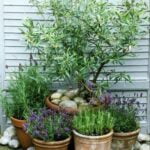Small rock gardens ideas are a fantastic way to bring natural elements and visual interest to any outdoor space. Whether you have a small balcony or a spacious garden, small rock gardens can be a beautiful addition to your landscape design. In this article, we will explore the benefits of small rock gardens, different types and designs, tips for choosing the right rocks and plants, as well as maintenance and design ideas.
Small rock gardens are miniature landscapes that incorporate various rocks, gravel, and plants to create a low-maintenance and visually stunning outdoor feature. They have gained popularity among homeowners and garden enthusiasts due to their versatility and ability to thrive in virtually any outdoor setting. From providing texture and depth to enhancing the overall aesthetics of the space, small rock gardens offer numerous advantages that make them a great addition to any outdoor area.
With various styles and designs available, such as Japanese rock gardens, alpine rock gardens, and desert rock gardens, there’s something for every taste and preference. In the following sections, we will delve into the different types of small rock gardens, from traditional zen-inspired designs to rugged alpine landscapes.
Additionally, we will provide tips on selecting the right rocks for your small rock garden based on size, color, and texture. So whether you’re looking for minimalist elegance or a more lush and colorful display, there are endless possibilities for creating a unique small rock garden that suits your individual style.
Benefits of Small Rock Gardens
Small rock gardens bring a variety of benefits to outdoor spaces, making them a popular choice for homeowners and garden enthusiasts. One of the key advantages of small rock gardens is their low maintenance nature. Unlike traditional gardens that require regular watering, weeding, and fertilizing, rock gardens are relatively low-maintenance once they are established. This makes them an ideal option for busy individuals who want to enjoy a beautiful garden without spending hours on upkeep.
In addition to being low-maintenance, small rock gardens also offer excellent drainage for plants. The porous nature of the rocks allows water to flow through the soil easily, preventing waterlogged conditions that can harm many plant species. This makes rock gardens particularly well-suited for areas with heavy rainfall or clay soils where drainage may be an issue.
Furthermore, small rock gardens provide a unique aesthetic appeal to outdoor spaces. The combination of rocks and carefully selected plants creates an eye-catching display that can enhance the overall look of a yard or garden. Whether you prefer a tranquil Japanese rock garden or a colorful alpine rock garden, there are endless possibilities for creating visually stunning landscapes with small rock gardens.
Additionally, small rock gardens can also act as natural barriers or focal points within a larger landscape design. By strategically placing rock gardens in certain areas of your yard, you can create visual interest and define different sections of your outdoor space. Whether used as borders along pathways or as standalone features in open areas, small rock gardens can add dimension and character to any outdoor environment.
Types of Small Rock Gardens
When it comes to creating a small rock garden, there are various styles and designs to choose from. Each type of rock garden offers its unique aesthetic and set of benefits, making it important to consider the specific features of each style before starting your project.
Here are some popular types of small rock gardens:
1. Japanese Rock Gardens: Also known as “zen gardens,” these are characterized by their minimalistic design and focus on tranquility. Typically consisting of carefully raked gravel or sand to represent water and strategically placed rocks to symbolize mountains, Japanese rock gardens offer a peaceful and meditative space for contemplation.
2. Alpine Rock Gardens: Inspired by the rugged and breathtaking landscapes of high-altitude mountain regions, alpine rock gardens feature a mix of pebbles, stones, and boulders arranged to mimic the natural terrain. These gardens often include plants that thrive in harsh conditions, such as dwarf conifers, alpine flowers, and creeping ground covers.
3. Desert Rock Gardens: As the name suggests, desert rock gardens are designed to mimic the arid environment of desert landscapes. Characterized by an abundance of cacti, succulents, and other drought-tolerant plants, these gardens typically incorporate sandy or rocky soil and large boulders to create a striking display of desert flora.
Whether you prefer the serene simplicity of a Japanese rock garden, the rugged beauty of an alpine rock garden, or the exotic allure of a desert rock garden, there’s a style to suit every preference and outdoor space. By carefully considering the features and requirements of each type, you can create a small rock garden that perfectly complements your home’s aesthetic while providing a peaceful retreat for relaxation and contemplation.
Choosing the Right Rocks
When it comes to creating a small rock garden, choosing the right rocks is essential for achieving the desired aesthetic and ensuring the success of your garden. The size, color, and texture of the rocks you select will greatly impact the overall look and feel of your rock garden. One of the most important aspects to consider when choosing rocks for your small rock garden is their size.
It’s best to opt for a variety of sizes to create visual interest and depth in your garden. Larger rocks can serve as focal points, while smaller rocks can be used to fill in gaps and create a sense of unity.
In addition to size, the color of the rocks you choose will play a crucial role in the overall appearance of your small rock garden. Earthy tones such as browns, grays, and tans are commonly used in rock gardens for a natural and cohesive look. However, don’t be afraid to add pops of color with vibrant or unique rock hues if it fits your design vision.
Texture is another important consideration when selecting rocks for your small rock garden. Smooth rocks can add a calming and serene feel to your garden, while rough or jagged rocks can create a more dynamic and rugged appearance. Combining different textures can add dimension and visual appeal to your rock garden design.
When choosing rocks for your small rock garden, it’s also crucial to consider the practicality of each stone. Think about how each rock will fit into the overall layout of your garden and how it will interact with other elements such as plants or pathways. With careful consideration and planning, you can select stones that not only look beautiful but also work cohesively with the rest of your small rock garden design.
| Choosing Rocks | Tips |
|---|---|
| Size | Opt for a variety of sizes |
| Color | Earthy tones for a natural look; add pops of color if desired |
| Texture | Consider smooth vs rough/jagged textures; mix textures for dimension |
Planting in Small Rock Gardens
Choosing Plants for Small Rock Gardens
When selecting plants for your small rock garden, consider the growing conditions of your specific location. Take into account factors such as sunlight exposure, soil type, and climate. Choose plants that are suited to these conditions and will complement the overall design of your rock garden.
Arranging Plants in Small Rock Gardens
Once you have chosen the right plants for your small rock garden, it’s important to arrange them in a visually appealing way. Consider the height, color, and texture of each plant when planning their placement within the garden. Group together plants with similar needs for water and sunlight to ensure they thrive in their new environment.
Maintaining Plants in Small Rock Gardens
Proper maintenance is crucial for keeping the plants in your small rock garden healthy and vibrant. Regular watering, mulching, and occasional pruning are necessary tasks to ensure that your chosen plants continue to thrive in their rocky environment. Pay attention to individual plant care requirements and make adjustments as needed to promote ongoing health and growth within your small rock garden.
By carefully choosing and arranging plants that thrive in rock gardens, such as succulents, alpines, and ground covers, you can create a stunning display that will enhance any outdoor space. Whether you have a balcony, patio or front yard, incorporating these plant options into your small rock garden will add beauty and interest while requiring minimal maintenance.
Design Tips for Small Rock Gardens
Designing a small rock garden can be a fun and creative project that adds visual interest to your outdoor space. When it comes to creating visually appealing and balanced small rock garden layouts, there are a few key design tips to keep in mind.
First, consider the overall shape and layout of your small rock garden. Whether you have a compact corner or a larger area to work with, the shape of your rock garden should complement the surrounding landscape. You can create curving lines or asymmetrical shapes for a more natural look, or opt for straight lines and geometric shapes for a more contemporary feel.
In addition to the shape, the placement of rocks in your small rock garden is crucial. Vary the size and height of the rocks to add depth and dimension to the space. Taller rocks can serve as focal points, while smaller rocks can be used to fill in gaps and create texture. Be sure to leave enough space between rocks for planting, while also considering how they will interact with other elements such as walkways or ponds.
Lastly, think about color and texture when designing your small rock garden. Choose rocks that complement the colors of surrounding plants or hardscape features. Mixing different types of rocks – such as smooth river rocks, rough granite boulders, or colorful pebbles – can add visual interest and variety to your small rock garden.
| Key Design Tips | Details |
|---|---|
| Shape and Layout | Create curving lines for a natural look or straight lines for a contemporary feel |
| Placement of Rocks | Vary size and height for depth, leave space for planting, consider interaction with other elements |
| Color and Texture | Choose rocks that complement surrounding features, mix different types for visual interest |
Maintaining Small Rock Gardens
Maintaining a small rock garden is essential to keep it looking beautiful and thriving throughout the year. Here are some tips for keeping your small rock garden in top shape:
1. Weeding: Regularly removing weeds from your small rock garden is crucial to prevent them from competing with your plants for nutrients and resources. Be sure to carefully pull out any weeds by hand or use a small gardening tool to avoid disturbing the surrounding rocks and plants.
2. Pruning: Proper pruning of plants in your small rock garden is important for maintaining their shape and encouraging healthy growth. Trim back any overgrown branches or foliage, especially those that may be encroaching on neighboring plants or covering the rocks.
3. Watering: One of the key considerations when maintaining a small rock garden is proper watering. Since rocks can absorb heat during the day and release it at night, moisture evaporates quickly from the soil around them. Therefore, it’s important to water your small rock garden more frequently, especially during hot and dry weather.
By following these maintenance tips, your small rock garden will continue to be a stunning focal point in your outdoor space. Whether you have a Japanese rock garden, alpine rock garden, or desert rock garden, regular care will ensure that it remains visually appealing and thriving with life all year long.
Small Rock Garden Ideas for Different Spaces
Incorporating small rock gardens into various outdoor spaces can bring a touch of natural beauty and tranquility to your home. Whether you have a tiny balcony, a cozy patio, or a spacious front yard, small rock gardens can be a versatile and visually appealing addition to your outdoor space. With the right planning and design, you can create a charming oasis that complements your surroundings and adds depth and texture to your landscape.
For balconies or small patios, consider creating a miniature rock garden in a container or raised bed. Choose small-scale rocks and plants that won’t overpower the limited space but still provide visual interest.
Succulents, alpines, and ground covers are excellent choices for these compact rock gardens as they thrive in shallow soil and are low-maintenance. You can also incorporate various accessories such as miniature sculptures, decorative pebbles, or small water features to enhance the overall look of your mini rock garden.
In larger outdoor spaces like front yards or expansive patios, you have more flexibility in designing your small rock garden. You can create pathways lined with rocks and intersperse larger boulders amidst smaller plants to add dimension to the landscape. Consider incorporating different types of rocks such as river rocks, lava rocks, or slate stones to create visual contrast and texture.
Additionally, you can use strategic lighting to highlight certain elements of your rock garden at night for added ambiance. No matter the size of your outdoor area, there are countless possibilities for creating beautiful and innovative small rock gardens that suit any space.

Welcome to my gardening blog! I am passionate about plants and enjoy sharing my knowledge and experiences with others. In this blog, I will write about everything related to gardening, from tips on how to get started to updates on my own garden projects.





